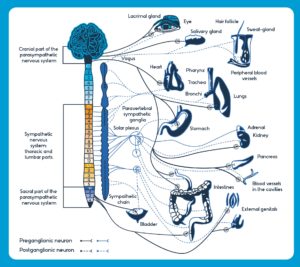The Vagus Nerve and Your Health
A Nerve You Never Heard of is Running Your Life!

Well, you’ve got some nerve! Yes! That nerve (your vagus nerve) regulates how stress affects you as well as your ability to calm yourself. It also determines your level of comfort in intimate and social situations and affects how well you digest your food.
A new scientific discovery is changing the way we think about our health, our relationships and our capacity to find fulfillment in our lives. This new theory is as revolutionary as the discovery of the germ theory. It demands that we examine every level of our thinking regarding physical health, emotional well-being and our capacity for resiliency.
The New Science that Explains it all: Polyvagal Theory
You may be thinking, poly-what? What is it and what does this have to do with me? That’s exactly what I thought as I began to read the jaw-breaking, complex research of Dr. Stephen Porges. His discoveries are changing our understanding of the nervous system and challenging what we have long thought of as effective techniques to deal with such issues as stress, burn out, anxiety and depression. Let’s see how this plays out in our own lives and in the lives of family and co-workers.
Basically, polyvagal theory states that, as humans we have not two but three branches of our nervous system. We were taught that we had two branches: fight/flight or freeze. Proges has demonstrated that, as humans, we have a third branch, a third way of staying safe, getting our needs met and calming our nervous system. He calls this the social engagement system and it stems from the vagus nerve that begins developing in utero and continues to develop with our first contacts after birth. As our caregiver is emotionally present and responsive, these tiny nerves in the inner ear thicken, allowing the baby to recognize a calming human voice. This continues as eye contact is made, the heart settles and digestion improves.
Our Social Engagement System
A well-developed vagus nerve is the foundation of our social engagement system. This is the body’s preferred line of defense. Initially our body uses an unconscious mechanism to discern threat or safety. If our bodily sense (our unconscious) detects safety (including psychological safety), we are able to connect with others to soothe our nervous system and digest our food. We also begin to trust that our needs will be met. Even as adults, part of our unconscious system is always surveying the environment, especially in interactions with others, asking “Am I really safe here?”
Safety in this context is much, much more than “Am I physically safe? As adults, most of us feel physically safe most of the time. However, we may not realize that beneath our conscious, thinking brain is the part of us that continually surveys the environment for emotional safety. Unconsciously we make judgments about how we are perceived by the people around us. Also unconsciously we ask ourselves, “Is it okay for me show up here? Is it okay for me to have feelings, express my thoughts and needs? Will I be judged, shamed or criticized?” This sense of safety, or lack of it, is directly connected with how well your nervous system has developed.
What if your vagus nerve is impaired?
If, like me, you didn’t have the experience of emotionally present caregivers, (If your mother didn’t have that experience, she can’t give it to you!) the development of your vagus nerve is likely impaired. This often results in anxiety, digestive problems, inability to accurately read social cues, either missing cues of others or misinterpreting other’s cues.
The good news is, it’s never too late! What we know now is that as we perceive a safe environment, in relationship with a present and caring other, we can have experiences that develop the vagus nerve, helping us calm the nervous system, reduce stress and feel content in our lives.
An example of an impaired vagus nerve
In looking at this, I think about my very earliest experience. My parents had a volatile relationship and separated when my brother was an infant. They really loved each other; they just couldn’t make it work. On Christmas day they got together for the afternoon and later found out I was on the way. Soon after, my mother’s sister and her baby died in childbirth. You can imagine my mother’s turmoil, anxiety, and grief. She was not able to be emotionally present for me.
As an adult as I worked on this in some intensive workshops, I experienced her anxiety and felt my infantile need to take care of her. Since that wasn’t possible, I felt inadequate. Interestingly, as I got older, I dedicated myself to taking care of everyone else, often at my own expense.
Stimulating your vagus nerve
You may consider your own early experiences, and without blame, begin to realize that your vagus nerve could use some development. When we practice the processes below, research demonstrates that we actually do increase the connections and develop a greater ability to calm our nervous system.
As you do these processes, you may find that self-care becomes easier, relationships go more smoothly, and you feel more creative and happy. You may also become healthier and feel more genuine satisfaction in your life. You don’t have to do them all. Just try a few and see what you notice. That way, you will be a lot happier with the nerve that’s running your life.
Two 2-minute practices that can change your life RIGHT NOW!
If you read the earlier blog on Instant Stress Relief, you may already be practicing this valuable exercise. If not, don’t miss it.
Vagal Nurturing (see our video of the following process)
- First, take a deep breath and notice your exhale as you pull the outer edges of your ears. The Chinese call this “pull ears, make happy,”
- Next, take a deep breath, move your hands to cover your eyes, focusing on your exhale.
- As you inhale, gently move your hands down to your jaws and imagine someone who cares for you is holding your face in their hands.
- Now glide your hands down the sides of your neck, place them on your heart and notice your exhale.
- On the next inhale, glide your hands down your ribs and onto your belly, again with a long exhale.
- Now, just take that top hand and place it on your heart and focus on the exhale.
- The final step is releasing your arms, opening your hands to receive. Take a nice, deep breath as you imagine yourself receiving. If possible, when you’re ready, allow yourself to have eye contact with someone near you
Vagal Toning
Here is another exercise that may seem complex at first but after you do it once, it will become easy and it feels so good! Give it a try:
- Begin with your ears. Initially, put your fingers in your ear canals then move them up to find the space just above. Play with this until you find the spot that feels a bit tender. Then press gently as you inhale through your nose and exhale through your mouth as if you were blowing through a straw.
- Now as you inhale, move your fingers to your eye area and massage all around your eyes as you exhale through your imaginary straw.
- On your next inhalation move your fingers to your jaw and massage those muscles as you allow a long exhale.
- Next move your fingers down to massage the sides and back of your neck, paying attention to your long exhale.
- As you inhale, move your fingers out and down a bit and “dig in” a bit, massaging those tight muscles at the top of your shoulders as you again exhale through your imaginary straw.
- On your next inhale allow your arms to cross and give yourself a big hug, holding or massaging your upper arms.
- Notice what you experience in your body as you come back into the room. If you can have eye contact with someone, do so. If not, try to imagine someone who would wish you well, an ally, standing there beside you or holding your back, supporting you as you prepare to complete the rest of your day.
Note: You can do this process with one big breath for each point or you can take a bit more time and spend two breaths or more with each point.
10 Additional Processes that Stimulate Your Vagus Nerve
- Breathe deeply and slowly. Taking slow, rhythmic, diaphragmatic breaths stimulates and tones the vagus nerve.
- Humming, Singing, Chanting. The vagus nerve is connected to the vocal cords, so humming and singing stimulates it. Hum a song, repeat the sound “OM,” sing loudly or softly, sing with others.
- Experience cold. You can begin by splashing your face with cold water. You might also bathe or swim in cold water, and drink cold water.
- Mindfulness meditation. This promotes feelings of goodwill towards yourself and others. Studies show that increasing positive emotions can lead to increased social connection and feelings of closeness, plus enhanced in vagal tone.
- Yoga. Research has shown that yoga increases vagus nerve activity, helps calm and strengthen the nervous system.
- Exercise. Exercise stimulates blood flow in the gut and, therefore, the vagus nerve.
- Laughter. Laughter really is the best medicine! Laughing with friends is even better.
- Massage. Massaging the carotid artery in the neck, pressure massage, foot massage and general body massage all help increase vagal tone.
- Create nurturing social relationships. This not only stimulates the vagus nerve but is critical for health and well being.
- Eye contact. Have appropriate, meaningful eye contact as often as possible.
Watch for future blog posts where we will feature even more specific ways to stimulate your vagus nerve and calm your nervous system.
More resources:
This article was written by Marti Glenn, Ph.D., Ryzio Clinical Director
